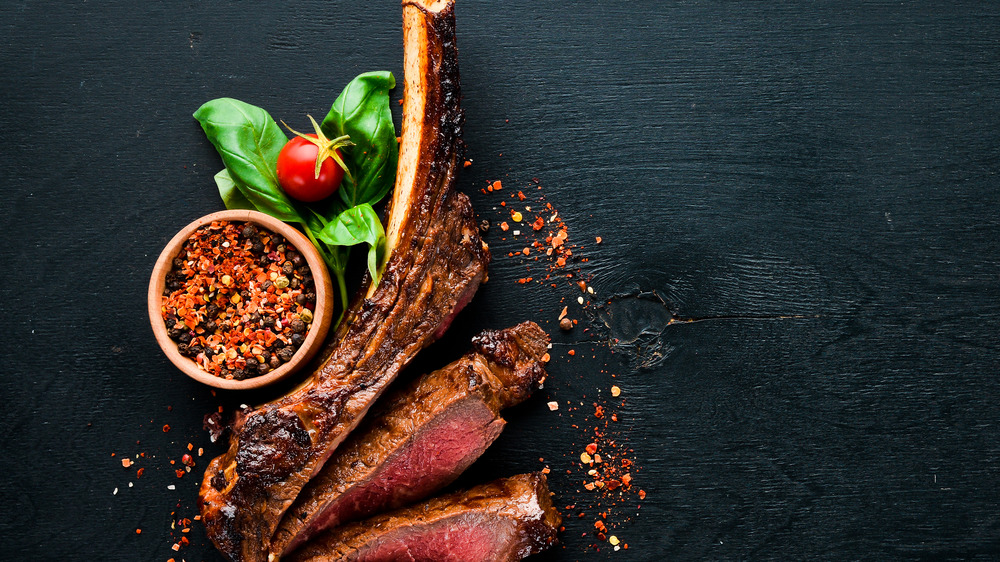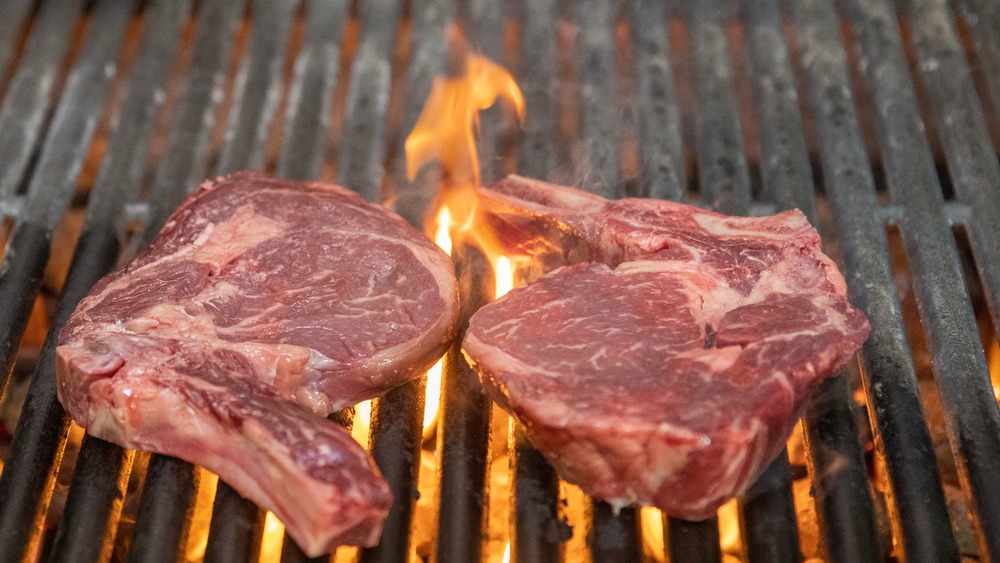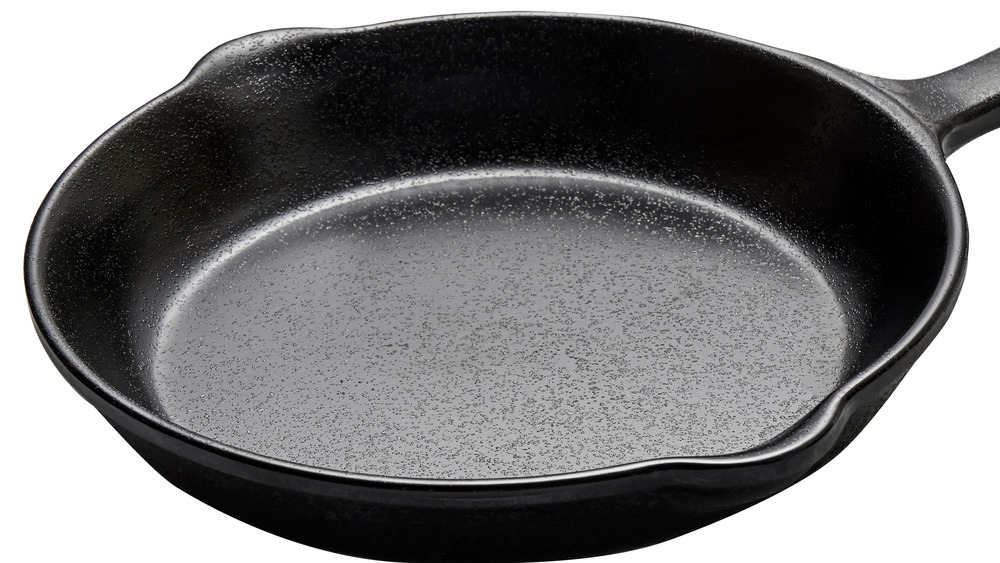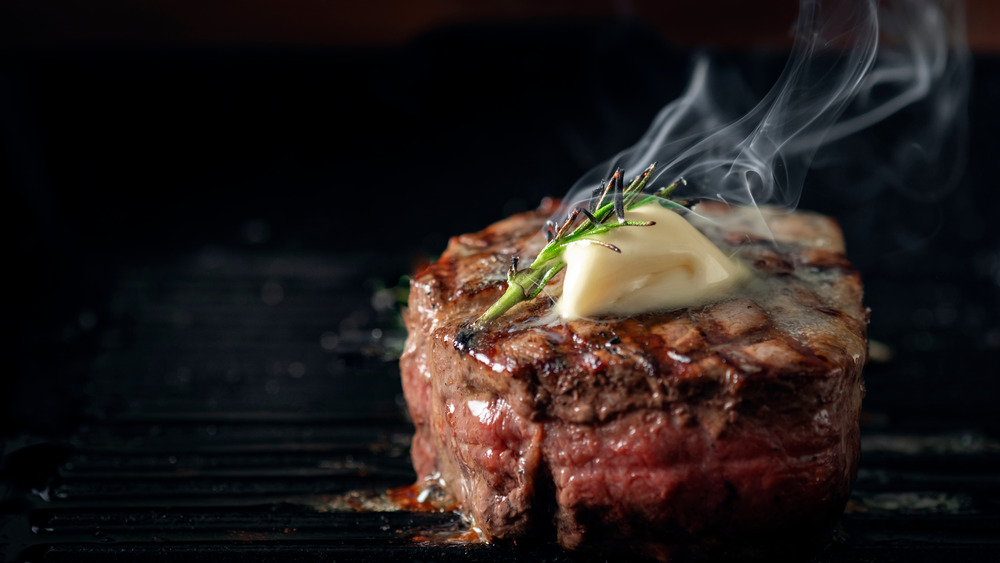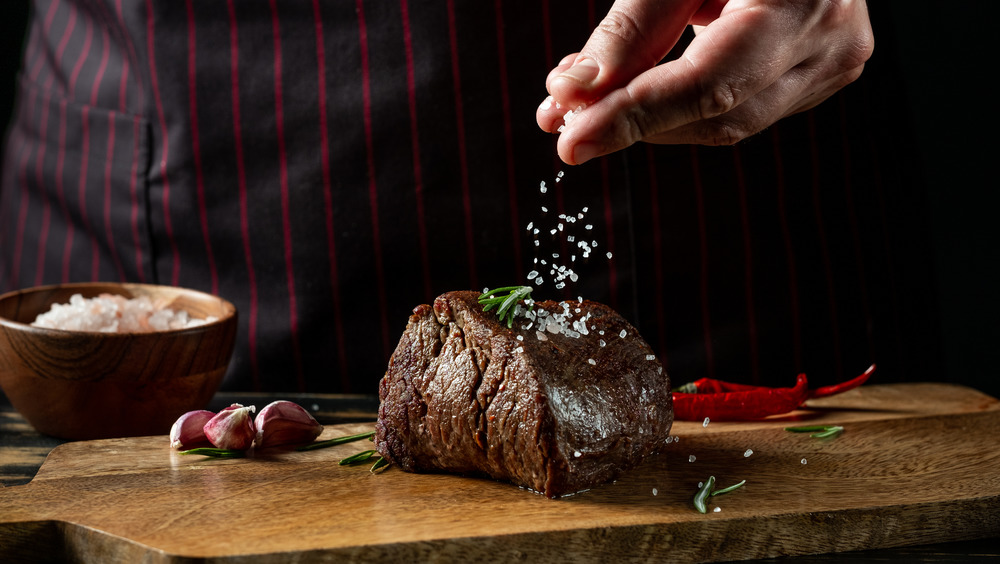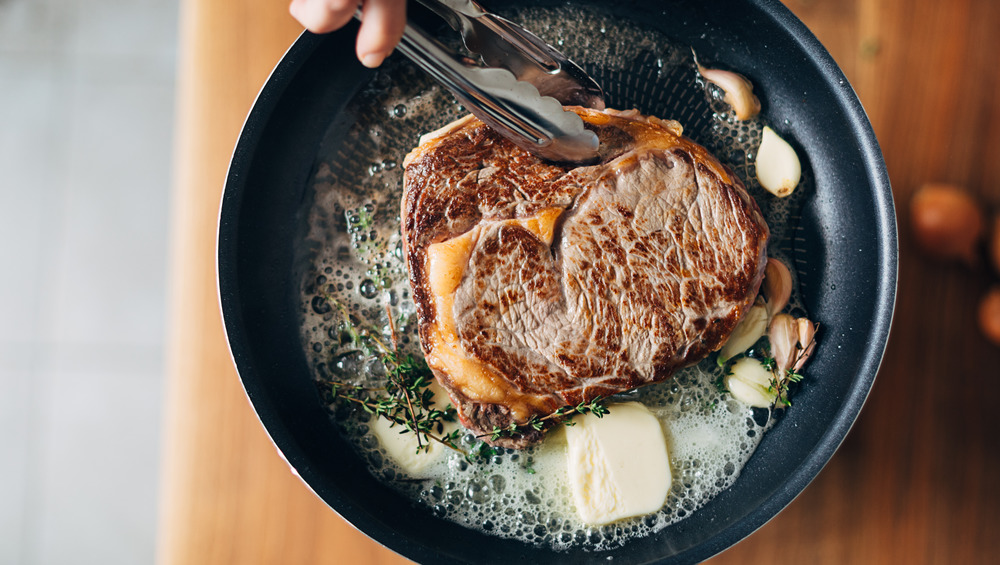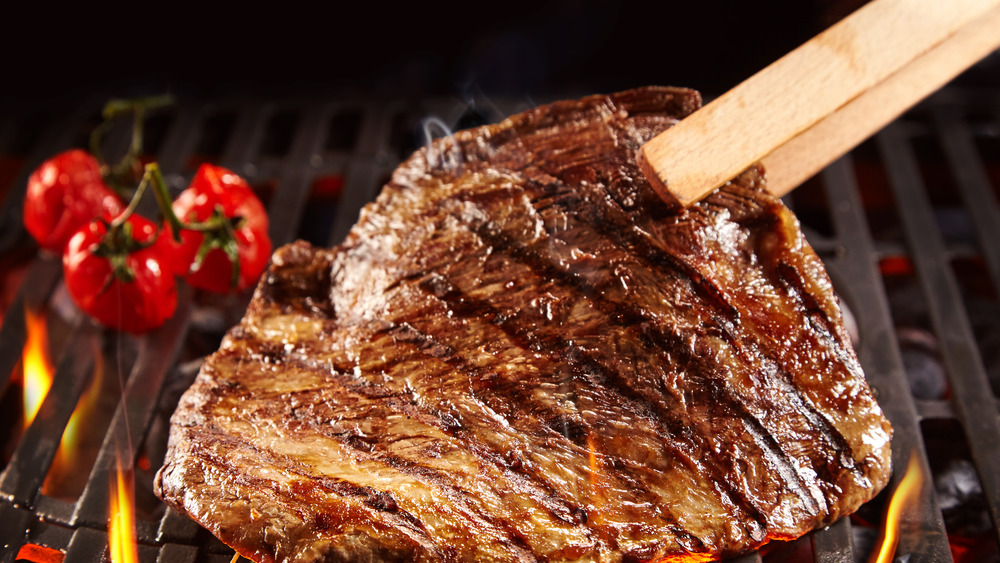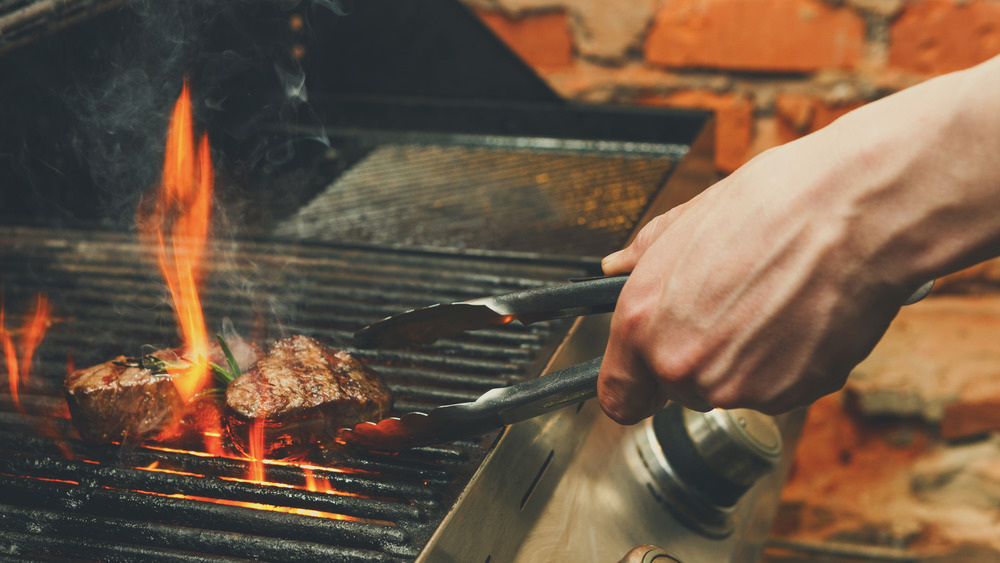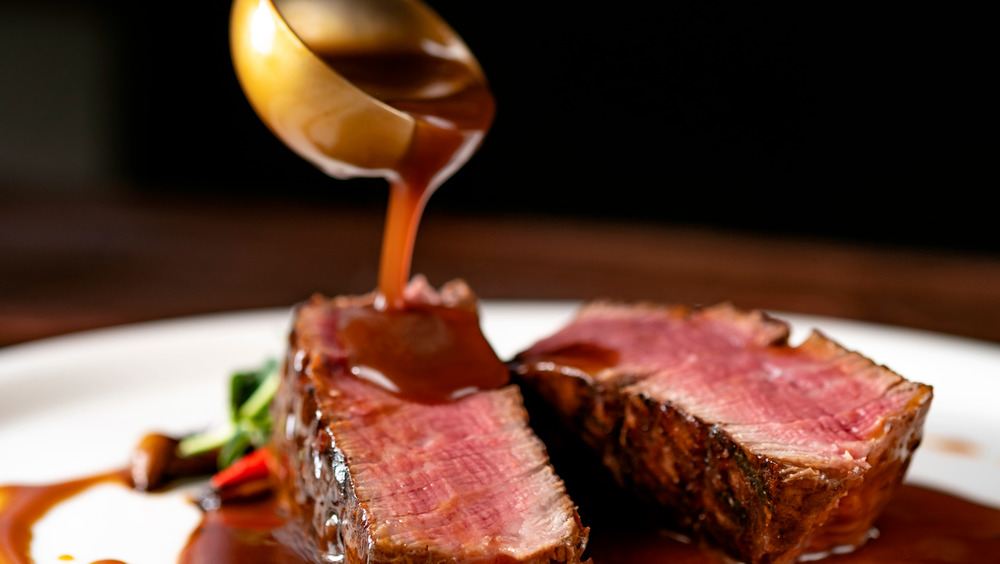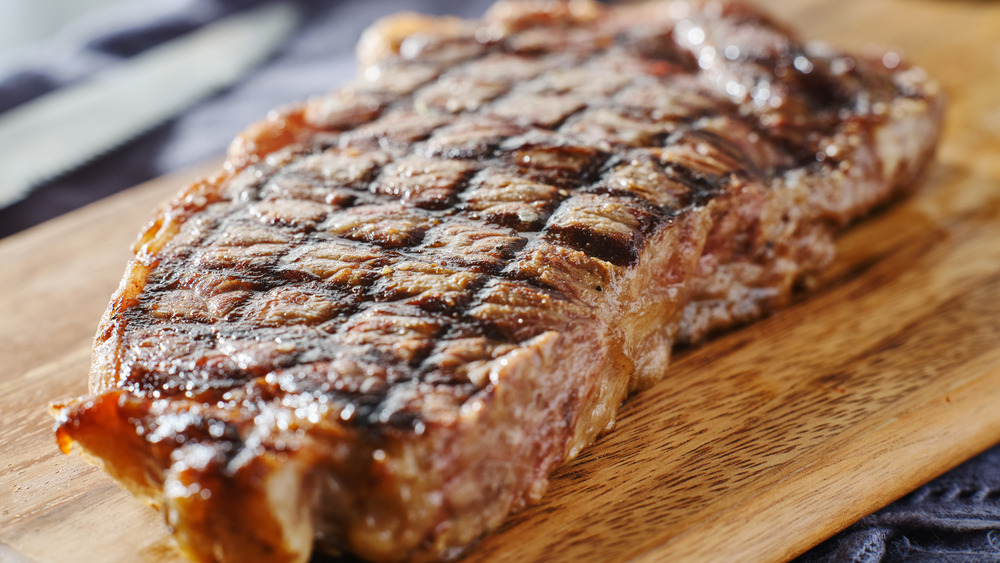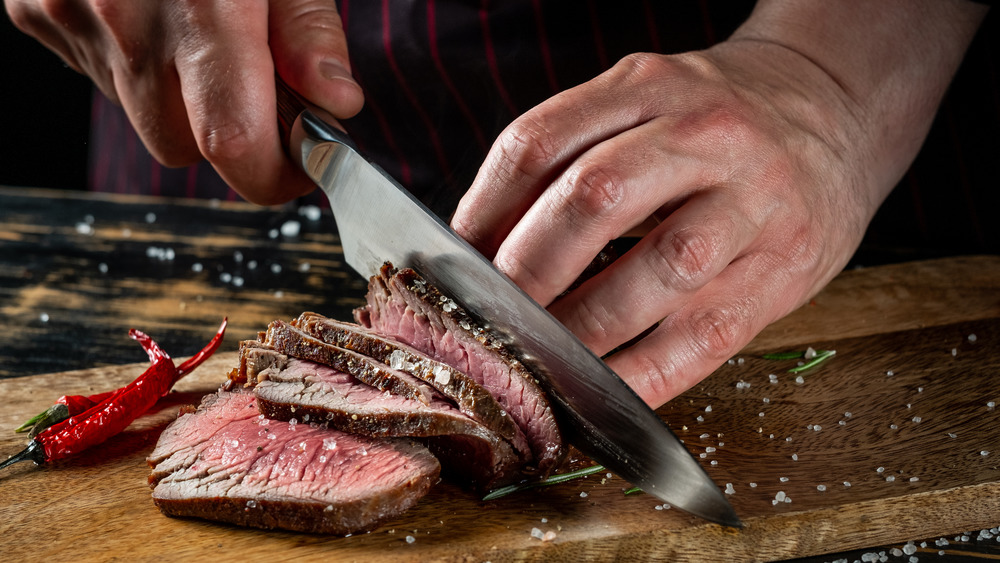You've Been Pan Searing Steak Wrong This Whole Time
When it comes to making a good steak, the techniques look pretty simple, but things can go very wrong if you don't know what you're doing. When searing a steak, for example, you'll want to get started with scorching heat and be sure to use the right pan. Then, it's all about getting a great sear and building flavor. In fact, when you throw that ribeye in a hot pan, you'll want to instantly hear a glorious sizzle — that's how you know you're getting a good sear while building a beautiful crust for your juicy, succulent steak.
Does that sound kind of sexy? Well, a beautiful seared steak is downright sizzling on the steam-o-meter. According to the pros, it all starts with finding the right cut of meat and then treating it right until it gets on your plate. Take the right steps, and your next seared steak will fly off your guests' plates. Let's go over exactly how you can take your seared steak to the next level.
Use the right cut when pan searing steak
A great steak starts with the right cut of meat, as different steaks will deliver different levels of tenderness and flavor and require different cooking times.
"Popular steaks to pan sear are tenderloin, hanger steak, rib-eye, rump steak and sirloin," Chef Denise Spencer-Walker of the UK Agriculture and Horticulture Development Board (AHDB) told Mashed. The steak should be at room temperature before cooking, and it's recommended to pat the surface of the steak to dry it before cooking, as this will help to form a good crust.
If you really want to nail a seared steak, spending extra on aged beef might also help.
"We use a 35 dry-aged steak," says New York-based Brooklyn Chop House Director of Operations and author of Damn Good Dumplings, Stratis Morfogen, to Mashed. In other words, the beef has been hung up to dry by butchers in specific conditions for 35 days (no, you do not want to try that at home!). According to Morforgen, the steak also has to look like a white marble floor — the more marble the better.
To prep the steaks, Morfogen uses kosher salt and a dash of butter on top. As for time required searing, it depends on temperature and cut.
"...If we use a bone in 24-ounce ribeye and when the grills are north of 450 degrees, it takes about 15 minutes to 20 minutes for medium-rare and that's in addition to a nice crispy shell," said Morfogen.
Make sure you heat your steak searing pan in the oven before starting
Once the steak has been sitting for about 20 to 30 minutes with the salt, it's time to get your pan ready. "I use a cast iron deep dish pan," Michael Haas of Angry BBQ told Mashed.
The pan should be thick-bottomed and good-quality. "The pan should be very hot to sear in the juices and give a nice crust and caramelization on the outside of the steak," Chef David Cox of NORMS said to Mashed.
Cast Iron holds and conducts heat evenly and efficiently. "Cast Iron requires maintenance and upkeep so always make sure your pan is well seasoned [with] vegetable oil or butter after every use," said Haas, who gives the pan a quick rub with vegetable oil on a paper towel to assure every part of the pan is oiled and ready for use.
But a cast iron is not your only option. Denise Spencer-Walker of the United Kingdom's Agriculture and Horticulture Development Board also recommends a heavy-duty thick frying pan or a heavy griddle pan.
Also, be sure you don't overcrowd the pan, as it will cool off and juices will start to form, which could possibly steam the steaks. On that note, don't forget to dry your steaks with a paper towel before cooking. "If you do not remove that excess moisture on the steak before it hits your hot pan, it will quickly evaporate and essentially steam your steak," said Haas.
Make sure you coat both sides of your seared steak with oil or fat
Once the steak hits the pan, that's when you start timing your cooking. "If I'm doing a one-inch thick cut steak, I'm planning on flipping the steak after 1 minute and 30 seconds," said Michael Haas of Angry BBQ to Mashed.
After the first flip is when Hass throws in a couple of tablespoons of butter and moves it around the steak and pan. "Once the butter melts I take a spoon and keep spooning the melted butter on the top of the steak," said Haas, who feels this adds flavor and helps with the steak crust when it comes time to do the next flip. "After another 1 minute and 30 seconds I'm flipping again and start spooning the melted butter again."
If you're avoiding butter, oil is another good option. Chef Denise Spencer-Walker of the UK Agriculture and Horticulture Development Board (AHDB) told Mashed that it's recommended you coat both sides of the steaks with a mild oil, such as canola, and once the steak is searing, you can add butter to the pan, along with garlic cloves or fresh herbs for extra flavor.
Another option is to put oil on the steak (versus in the pan) to evenly transfer the heat to the steak while cooking. Ian Rough, Corporate Chef for Ocean Prime steak and seafood restaurants, advised to Mashed that putting oil in the pan isn't recommended because it can burn.
Make sure you season before adding your steak to the pan for searing
A well-seasoned meat is a great piece of meat, but sadly the reverse is also true — an under-seasoned piece of meat will often be quite disappointing. But sometimes people invest so much time in getting a great pan and a beautiful steak that they forget this part of the process!
Denise Spencer-Walker of the UK Agriculture and Horticulture Development Board recommends seasoning the steak with a little salt up to two hours before cooking, and then she advises adding pepper just before cooking. "Contrary to popular belief, seasoning a steak with salt ahead of time doesn't draw out the moisture — it actually gives the steak time to absorb the salt and the meat becomes more evenly seasoned throughout," said Spencer-Walker to Mashed.
While something like salt is easy to forget, any restaurant chef will tell you salt is a big part of what makes their food delicious once it gets to the customer, so learn from them!
Sear your steak each side, but don't do it for too long
Once you set the steak into the pan to sear it, don't jiggle the pan or move the steak — you want it to stay put and focus on that sear. The time varies, according to Steve Gebhardt, Director of Culinary, Creative Cloud Concepts in Los Angeles, CA, which includes Holy Cow BBQ. Gebhardt suggested to Mashed that you leave the steak until you see the corners starting to brown and then, flip the steak and do the same for the other side.
And while searing, don't forget to cook the sides. "Many people forget to cook those sides which usually have a fatty piece that could use some searing to melt and develop flavor," former Food Network Star finalist Chef Chris Valdes told Mashed. This is simple, says Valdes: Just tilt your protein sideways using tongs and allow it to cook for about two minutes, or until it is seared, and repeat the process on all sides.
Should you season your seared steak again?
Whether or not to season your meat once again after it's in the pan is a complicated decision. The reality is that if you season properly at the onset, you probably don't need to season again. Also, once you sear the meat, it's very difficult for new seasoning to get past the crust. Of course, it's your dinner, so do what feels right to you and season accordingly, which is what some chefs do anyway.
Some experts love adding fresh herbs, such as a few sprigs of fresh thyme or rosemary, to the pan along with the steaks during the cooking process. This is optional but delicious and can create a luxurious pan gravy to add to your finished steak. Fresh herbs added at the beginning of the cooking process may burn before the steak is done, though, so if you go fresh, adding them toward the end would make sense.
Don't forget to flip your meat when searing steak
The time you spend searing will depend on how well you like your steak cooked. To build up an even crust on both sides, you will want to cook the meat for the same amount of time on each side, and Denise Spencer-Walker of the UK Agriculture and Horticulture Development Board recommends only turning the steak once.
But be careful not to over-flip your meat. You could interrupt the cooking and ruin your beautiful sear. "You really only need to sear each side of the steak once. You can however, sear each side twice to give a thicker crust on the steak, if you so desire," said Steve Gebhardt, Director of Culinary, Creative Cloud Concepts in Los Angeles, CA, which includes Holy Cow BBQ, to Mashed.
Be patient and then even more patient. Let the steak cook and form a crust before flipping. "Flipping too soon cools the pan and prevents the crust from forming," Chef David Cox of NORMS, which has 20 locations in Southern California, told Mashed.
Continue pan searing your steak to desired doneness
Different chefs will have different techniques for cooking to a meat's desired doneness, or even for how to check if a steak is done in the first place. But the easiest method, especially if you are first starting it out, is probably investing in a meat thermometer.
"Know what the perfect steak looks like for you and know the temperature it needs to be," said Executive Chef Kraig Hansen of Fable Lounge in Nashville to Mashed.
Then of course, it's all about your preference: Do you like your steak rare? Medium? Well done? Rare will have an internal temperature of 120 degrees, medium rare is about 140 degrees, and well-done steak is 160 degrees or higher. When cooking, always remove your steak from the cast iron at about the 10 degree mark before your specific temperature, as all steaks will have carryover cooking, suggests Hansen.
Smaller steaks can be fully cooked on top of the stove with just the burner. For larger steaks, you can put the whole sauté pan and steak in an oven and set to 375 degrees, flipping the steak occasionally until done.
Let your seared steak rest before serving
Letting meat rest before eating it is an essential part of the process that is often missed, and it's understandable — people are hungry and that steak is delicious! But resting is very important and should never be skipped, as resting lets the juices in the meat redistribute evenly, and that translates to a more evenly cooked and juicy (and delicious) steak. So, don't skip out on that super important resting time — your steak (and dinner guests) will thank you for it.
Executive Chef Kraig Hansen of Fable Lounge in Nashville told Mashed it's preferred to allow any type of steak to rest at least two minutes prior to serving or slicing. And it's advised to always rest on a plate or cutting board — and not in the cooking pan — as this will continue cooking the steak and will prevent it from actually resting.
"I always prefer to serve steak sliced. It makes it easier for you and your guests to enjoy without the struggle from a possibly dull steak knife," said Hansen. Any resting juices should be poured over the steak or into the accompanying sauce before serving.
If you're worried your steak might get cold, simply take a piece of aluminum foil and place it on top of your pan without closing the sides so the steak can breathe.
How to cut and serve your seared steak
Hard to believe, but as important as knowing how to prepare and cook a steak is, how to cut and serve it is very important as well. First, you'll wan to make sure to grab a super sharp knife before you get started. You don't want a ripped and torn steak!
Many chefs suggest cutting the steak against the grain, which is the best way to get really tender, beautiful slices of meat. Why go through all the trouble of cooking it perfectly to just end up with a chewy or tough steak? The ideal knife and cutting technique will allow that steak to cut through the meat as if it was butter.
If you're serving the steaks unsliced, this is when they will be transferred to plate and served right away. For finishing or accompaniment, Chef Denise Spencer-Walker of the UK Agriculture and Horticulture Development Board has a few sauce recommendations, including a peppercorn sauce, a Béarnaise sauce, a red wine sauce or a chimichurri.
